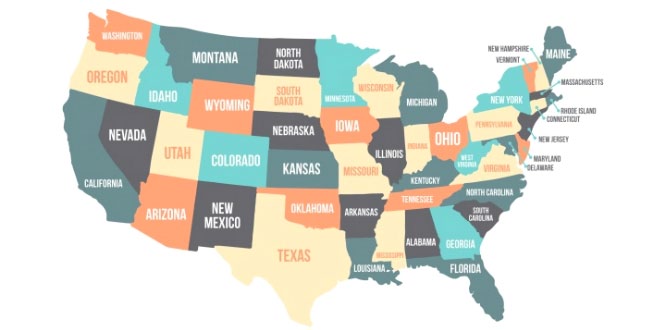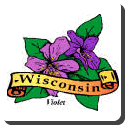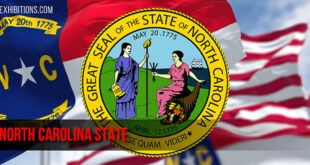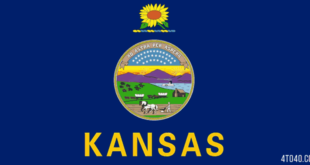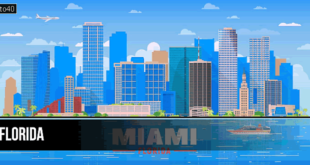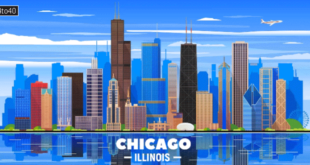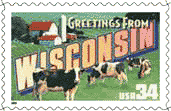 Wisconsin State ranks 16th (1990) in population among the 50 states and ranks 13th in the value of its manufacturing. As urbanized as the state has become, Wisconsin State remains the nation’s leading dairy state–accounting for almost 18% (1986) of U.S. milk and about half of U.S. cheese production–and consistently leads in the production of green peas, string beans, and sweet corn.
Wisconsin State ranks 16th (1990) in population among the 50 states and ranks 13th in the value of its manufacturing. As urbanized as the state has become, Wisconsin State remains the nation’s leading dairy state–accounting for almost 18% (1986) of U.S. milk and about half of U.S. cheese production–and consistently leads in the production of green peas, string beans, and sweet corn.
Wisconsin State: Land & Resources
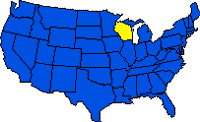 Wisconsin State may be divided into five physiographic regions: the Lake Superior lowland; the northern highland; the central sandy plain; the western upland, extending across the southwestern portion of Wisconsin; and the eastern ridges and lowlands.
Wisconsin State may be divided into five physiographic regions: the Lake Superior lowland; the northern highland; the central sandy plain; the western upland, extending across the southwestern portion of Wisconsin; and the eastern ridges and lowlands.
The Lake Superior lowland, once a glacial lake bed, is now a level to gently rolling red clay plain along Lake Superior in the northwestern corner of the state. Wisconsin’s largest physical region, the northern highland, extends south from the Lake Superior lowland and covers the northern third of the state. It consists essentially of a gently rolling glaciated plain of low local relief, although Rib Mountain in Marathon County reaches 592 m (1,940 ft). The state’s highest point, Timm’s Hill, at 595 m (1,951 ft), is located in southeastern Price County. In the crescent-shaped central sandy plain, edging along the southern margin of the northern highland and generally underlain by sand and sandstone formations, local relief varies from the flattish beds of ancient glacial lakes to rolling glacial moraines and, in a few western sections, scattered mesas and buttes.
The western upland, in the southwest, contains some of Wisconsin’s roughest landscape. Glaciation covered little of the region, so mature river systems have had millions of years to cut an intricate, hilly landscape. By contrast, the eastern ridges and lowlands region has low relief because of recent glaciation, but occasional moraines of up to 100 m (300 ft) mark places where glacial lobes stopped prior to withdrawal.
Climate
Mild to warm summers and cold, snowy winters characterize Wisconsin’s humid, continental climate. Average July temperatures range from 18 deg C (65 deg F) in the north to 24 deg C (75 deg F) in the south; January temperatures vary between minus 14 deg C (7 deg F) and minus 4 deg C (24 deg F). Lakes Michigan and Superior exert a moderating influence during both the summer and winter. Precipitation averages 760 mm (30 in) statewide, with the hilly west and domed elevations of the far north receiving as much as 915 mm (36 in).
Historical Sites
The Wisconsin State Historical Society maintains about 200 historical markers throughout the state. Built in 1926, Little Norway, near Mount Horeb, re-creates an early-19th-century Norwegian village. The Villa Louis (built 1843) at Prairie du Chien was the home of Hercules L. Dousman, a fur trader. The Roi-Porlier-Tank Cottage (erected 1776) in Green Bay is the oldest standing building in the state.
Tourism
Wisconsin’s travel and recreation industry is one of the state’s major sources of income. The famous Wisconsin Dells draws many visitors to that scenic region of the state, and deer, rabbit, and squirrel attract numerous hunters each fall. The state’s many lakes are used for boating, camping, fishing, and waterskiing. Chequamegon and Nicolet national forests cover extensive areas in northern Wisconsin. The Apostle Islands in Lake Michigan and the adjacent coastline are designated a national lakeshore; two separate areas of the Saint Croix River are national scenic river sites shared with Minnesota. Hundreds of town, village, city, and county parks complement Wisconsin’s state recreation areas.
Wisconsin State: History
Skilled big-game hunters arrived in Wisconsin 13,000 to 14,000 years ago–when sheets of glacial ice had just retreated–following mastodon, giant beavers, deer, caribou, and elk. About 6,000 years ago, the so-called Old Copper Indians lived in pole-frame structures covered with hides or bark. They used copper tools and buried their dead in ochre-lined graves.
Early Woodland cultures occupied portions of the state by about 600 BC, living by hunting, fishing, and collecting seeds. The Middle Woodland or Hopewell people arrived from the south about 100 BC with a limited form of agriculture, including cultivation of maize, pumpkin, and squash. They traded for goods made as far away as the Carolinas and the Gulf of Mexico. Overlapping in time with the Hopewell in southern Wisconsin, the Effigy Mound Builders left behind spectacular burial mounds, such as one near Madison that is in the form of a huge bird 2 m (6 ft) high with a wingspread of 190 m (624 ft).
By AD 1000, when both the Hopewell and the Effigy Mound Builder traditions were in decline, ancestors of the WINNEBAGO settled near Oshkosh and Platteville. A village people often residing in urbanlike settlements of as many as 100 persons, the Winnebago were primarily hunters and fishers. By the time the first Europeans arrived during the 17th century, they found FOX, HURON, ILLINOIS, KICKAPOO, MENOMINEE, MIAMI, OJIBWA, OTTAWA, POTAWATOMI, SAUK, and SIOUX, as well as the Winnebago.
European Period
The Frenchman Jean NICOLET, the first European to visit Wisconsin, arrived in the Green Bay area in 1634 to extend the fur trade; he also arranged a peace between the Winnebago and the Ottawa tribes. By 1665 the western Great Lakes basin was occupied by several hundred French fur traders, including Pierre Esprit RADISSON and Medard Groseilliers, who subsequently set up the field base for what would later become the HUDSON’s BAY COMPANY. The Jesuit priest Claude Jean ALLOUEZ established a mission at De Pere, just south of Green Bay, in 1671; also during the 1670s, Jacques MARQUETTE and Louis JOLLIET explored the upper Mississippi River region.
Beginning about 1735, French and Indian raiders, gathered from as far west as Wisconsin and, led by Charles Michel de LANGLADE, attacked the British along the Appalachian Mountains. Even before the last of the French and Indian Wars was over in 1763, however, the British had occupied former French outposts in Wisconsin. Twenty years later, following the American Revolution, possession of Wisconsin passed to the United States; it was not until shortly after the War of 1812, however, that the federal government garrisoned a post in the state. A New Yorker, James Lockwood, reported as late as 1827 that his was the only American family at Prairie du Chien in a community of Scottish and French settlers numbering nearly 200.
Territory and State
To protect Wisconsin’s few but growing number of American settlers, the federal government began, in 1817, to build Forts Howard (Green Bay), Crawford (Prairie du Chien), and Winnebago (Portage). Early commanders of these frontier outposts included Zachary Taylor and Jefferson Davis. From 1818 to 1836, Wisconsin was administered as part of the territory of Michigan.
A lead rush to the southwestern corner of Wisconsin encouraged Congress to grant separate territorial status on July 4, 1836, by which time 16,000 of the territory’s 22,000 inhabitants lived in the lead-ore district. The newly appointed governor, Henry Dodge, selected Belmont, a small crossroads village in Lafayette County, as the seat of the first territorial legislature. After much bribing of territorial delegates, however, Dodge’s political opponent, Judge James Doty of Green Bay, was able to have a swampy site–present-day Madison–in central Dane County, where Doty owned several hundred acres of land, chosen as the permanent territorial capital.
Another influx of immigrants between 1840 and 1850, much of it into eastern Wisconsin, increased the population of the territory tenfold to 305,000. After several referendums requesting statehood failed, voters finally elected to petition Congress in 1846. Two years later, on May 29, 1848, President Polk signed a bill making Wisconsin the 30th state.
Now securely part of the United States, Wisconsin saw its population burgeon during the 1850s to more than 700,000. During that decade nearly 300,000 immigrants entered the state, 45% of them from Germany. This meant, however, that when the Civil War broke out in 1861, many residents did not feel strongly about the Union cause; as a result, Wisconsin sent only 10% of its adult males to the Union armies.
The Civil War interrupted Wisconsin’s economic growth. The frontier of settlement remained virtually unchanged from 1860 to 1870. The next decade, however, saw farming expand northward, aided by such new harvesting machinery as the reaper and by the substitution of horses for oxen as draft animals. After the mid-1870s some farmers turned to dairying, at first concentrating on butter but later on cheese, because it spoiled less easily.
Next to agriculture, lumbering was the state’s leading industry from 1890 to 1910. Logs from the mature mixed forests of northern Wisconsin were floated down rivers to sawmills in the south, especially in Milwaukee and in the Fox River valley.
20th Century
A population that was 60% rural in 1900 was more than half urban by the time the Depression of the 1930s struck. Even by 1940 almost 14% of Wisconsin’s labor force was still unemployed, and two workers in three earned less than $1,000 a year. World War II cut unemployment and increased wages but brought new problems in its wake. Greater industrialization has depleted natural resources and has created pollutants that threaten tourism and dairy farming.
The thousands of blacks that have come to Wisconsin since 1945 suffer disproportionately from poor housing, high unemployment, and other social ills. In the early 1960s the federal government, believing that Indians would benefit from an end to reservations, made the Menominee Indian reservation Wisconsin’s 72d county. When this experiment turned out to be a failure, reservation status was restored by Congress in 1973. A 17-year legal battle between state officials and the Chippewa Indians was resolved in 1991 when the Chippewa won the right to gather plants, hunt, and spear fish off reservations in northern Wisconsin. The ruling, however, sets limits on the fishing catch and prevents the Chippewa from harvesting timber off the reservation.
Wisconsin State: Land
- Area: 169,653 sq km (65,503 sq mi); rank: 23th.
- Capital: Madison (1990 pop., 191,262).
- Largest city: Milwaukee (1990 pop., 628,088).
- Counties: 72.
- Elevations: highest–593 m (1,951 ft), at Timms Hill; lowest–177 m (581 ft), at Lake Michigan.
 Kids Portal For Parents India Kids Network
Kids Portal For Parents India Kids Network
